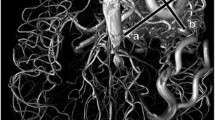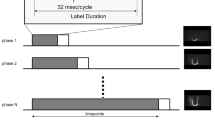Abstract
Objectives
To investigate in-vivo microanatomy of the subcallosal artery branching from the anterior communicating artery (ACoA) using time-of-flight (TOF) magnetic resonance angiography (MRA) at 7 Tesla.
Methods
Seventy-five subjects, including 15 healthy volunteers and 60 patients, were included in this prospective study. Three raters characterized branches from ACoA in maximum intensity projections of TOF MRA at 7 Tesla acquired with 0.22 × 0.22 × 0.41 mm3 resolution. Furthermore, course patterns and anatomical features of the subcallosal artery (maximum diameter, length, and branching angle from ACoA) were measured.
Results
Branches from the anterior communicating artery were visualized in 63 of 74 (85.1 %) subjects and were identified as the subcallosal artery (93.7 %) and the accessory anterior cerebral artery (6.3 %). The course of the subcallosal artery was classified into 3 groups; C-shaped (55.9 %), straight (16.9 %), and S-shaped (27.2 %). There was a significant difference between the branching angles of C-shaped and straight (p < 0.0001), between C-shaped and S-shaped (p < 0.0001), as well as between straight and S-shaped (p = 0.0113) course patterns.
Conclusions
High-resolution in-vivo 7 T TOF MRA can delineate the microanatomy of the subcallosal artery. Three main variants of course patterns and branching angles from ACoA could be identified.
Key Points
• In-vivo 7 Tesla TOF MRA can delineate the subcallosal artery microanatomy
• Three distinct course patterns of the subcallosal artery were identified
• Branching angles from ACoA significantly differed between subcallosal artery course patterns






Similar content being viewed by others
References
Windle BC (1888) The arteries forming the circle of Willis. J Anat Physiol 22:289–293
Senior H (1923) The blood vascular system. In: Morris H (ed) Human anatomy. Blakiston's Son, Philadelphia
Rubinstein HS (1944) The anterior communicating artery in man. J Neuropathol Exp Neurol 3:196–198
Krayenbühl HA, Yasargil MG (1968) Radiological anatomy and topography of the cerebral vessels. In: Cerebral angiography, 2nd edn. J.B. Lippincott, Philadelphia, pp 20–84
Baptista AG (1963) Studies on the arteries of the brain. II. The anterior cerebral artery: some anatomic features and their clinical implications. Neurology 13:825–835
Marino R (1976) The anterior cerebral artery: I. Anatomo-radiological study of its cortical territories. Surg Neurol 5:81–87
Perlmutter D, Rhoton AL Jr (1976) Microsurgical anatomy of the anterior cerebral-anterior communicating-recurrent artery complex. J Neurosurg 45:259–272
Yasargil MG, Smith RD, Young PH, Teddy PJ (1984) Anterior cerebral artery complex. In: Microneurosurgery, vol 1. Georg Thieme Verlag, Stuttgart, pp 92–128
Crowell RM, Morawetz RB (1977) The anterior communicating artery has significant branches. Stroke 8:272–273
Vincentelli F, Lehman G, Caruso G, Grisoli F, Rabehanta P, Gouaze A (1991) Extracerebral course of the perforating branches of the anterior communicating artery: microsurgical anatomical study. Surg Neurol 35:98–104
Marinkovic S, Milisavljevic M, Marinkovic Z (1990) Branches of the anterior communicating artery. Microsurgical anatomy. Acta Neurochir (Wien) 106:78–85
Ture U, Yasargil MG, Krisht AF (1996) The arteries of the corpus callosum: a microsurgical anatomic study. Neurosurgery 39:1075–1084, discussion 1084-1075
Serizawa T, Saeki N, Yamaura A (1997) Microsurgical anatomy and clinical significance of the anterior communicating artery and its perforating branches. Neurosurgery 40:1211–1216, discussion 1216-1218
Morioka M, Fujioka S, Itoyama Y, Ushio Y (1997) Ruptured distal accessory anterior cerebral artery aneurysm: case report. Neurosurgery 40:399–401, discussion 401-392
Rhoton AL Jr (2002) Aneurysms. Neurosurgery 51:S121–S158
Hattingen E, Rathert J, Raabe A, Anjorin A, Lanfermann H, Weidauer S (2007) Diffusion tensor tracking of fornix infarction. J Neurol Neurosurg Psychiatry 78:655–656
Mugikura S, Kikuchi H, Fujii T et al (2014) MR imaging of subcallosal artery infarct causing amnesia after surgery for anterior communicating artery aneurysm. Am J Neuroradiol 35:2293–2301
Yasargil MG, Smith RD, Young PH, Teddy PJ (1984) Anterior cerebral and anterior communicating artery aneurysms. In: Microneurosurgery. vol 2. Stuttgart, Georg Thieme Verlag, 165–231
Chan A, Ho S, Poon WS (2002) Neuropsychological sequelae of patients treated with microsurgical clipping or endovascular embolization for anterior communicating artery aneurysm. Eur Neurol 47:37–44
Meila D, Saliou G, Krings T (2015) Subcallosal artery stroke: infarction of the fornix and the genu of the corpus callosum. The importance of the anterior communicating artery complex. Case series and review of the literature. Neuroradiology 57:41–47
Mortimer AM, Steinfort B, Faulder K et al (2015) Rates of local procedural-related structural injury following clipping or coiling of anterior communicating artery aneurysms. J Neurointerv Surg. doi:10.1136/neurintsurg-2014-011620
Johst S, Wrede KH, Ladd ME, Maderwald S (2012) Time-of-flight magnetic resonance angiography at 7 T using venous saturation pulses with reduced flip angles. Investig Radiol 47:445–450
Wrede KH, Johst S, Dammann P et al (2014) Improved cerebral time-of-flight magnetic resonance angiography at 7 Tesla-feasibility study and preliminary results using optimized venous saturation pulses. PLoS One 9, e106697, http://journals.plos.org/plosone/article?id=10.1371/journal.pone.0106697
Wrede KH, Dammann P, Johst S et al (2015) Non-enhanced MR imaging of cerebral arteriovenous malformations at 7 Tesla. Eur Radiol. doi:10.1007/s00330-015-3875-0
Cho ZH, Kang CK, Han JY et al (2008) Observation of the lenticulostriate arteries in the human brain in vivo using 7.0 T MR angiography. Stroke 39:1604–1606
Hendrikse J, Zwanenburg JJ, Visser F, Takahara T, Luijten P (2008) Noninvasive depiction of the lenticulostriate arteries with time-of-flight MR angiography at 7.0 T. Cerebrovasc Dis 26:624–629
Liem MK, van der Grond J, Versluis MJ et al (2010) Lenticulostriate arterial lumina are normal in cerebral autosomal-dominant arteriopathy with subcortical infarcts and leukoencephalopathy: a high-field in vivo MRI study. Stroke 41:2812–2816
Harteveld AA, De Cocker LJ, Dieleman N et al (2015) High-resolution postcontrast time-of-flight MR angiography of intracranial perforators at 7.0 Tesla. PLoS One 10, e0121051, http://journals.plos.org/plosone/article?id=10.1371/journal.pone.0121051
Acknowledgments
The authors would like to thank Lena C. Schäfer (RT) for performing all the 7 Tesla examinations. The scientific guarantor of this publication is Dr. Karsten H Wrede. The authors of this manuscript declare no relationships with any companies, whose products or services may be related to the subject matter of the article. This study has received funding by University Duisburg Essen (IFORES grant). No complex statistical methods were necessary for this paper. Institutional Review Board approval was obtained. Written informed consent was obtained from all subjects (patients) in this study. Methodology: prospective, observational, multicenter study.
Author information
Authors and Affiliations
Corresponding author
Rights and permissions
About this article
Cite this article
Matsushige, T., Chen, B., Dammann, P. et al. Microanatomy of the subcallosal artery: an in-vivo 7 T magnetic resonance angiography study. Eur Radiol 26, 2908–2914 (2016). https://doi.org/10.1007/s00330-015-4117-1
Received:
Revised:
Accepted:
Published:
Issue Date:
DOI: https://doi.org/10.1007/s00330-015-4117-1




